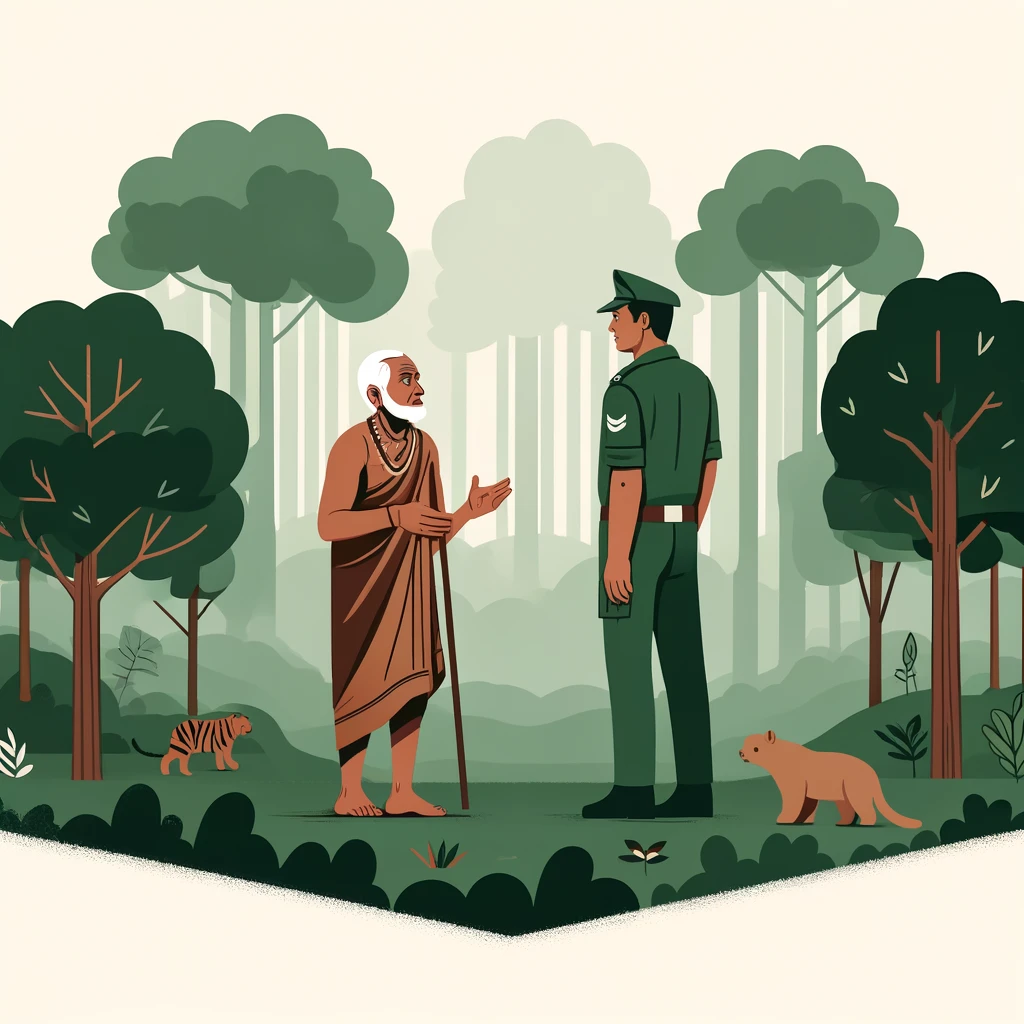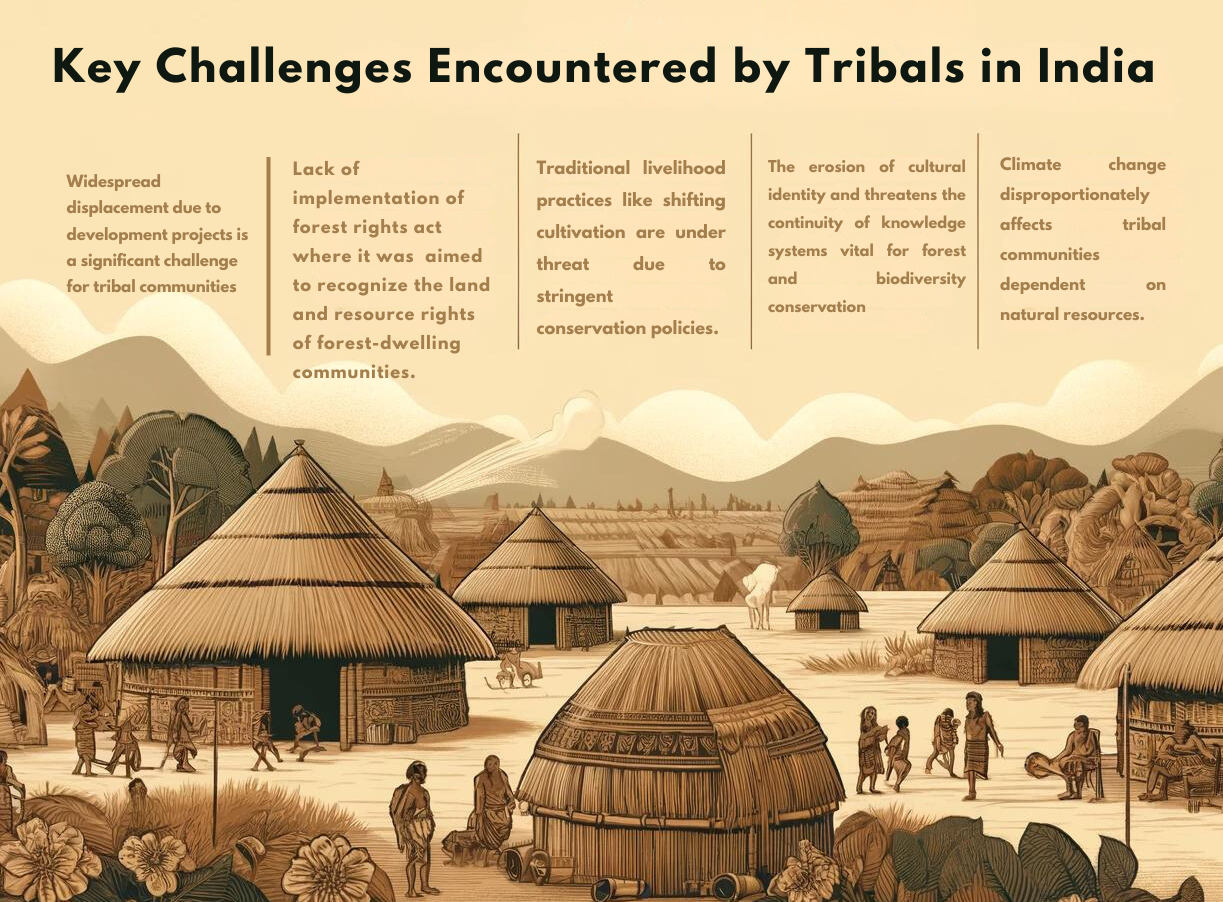Introduction
In recent times, the Indian President has emphasized the critical role of tribal knowledge in forest conservation and climate change mitigation. Tribal communities have long lived in harmony with nature, preserving forests and biodiversity. As we face environmental challenges, integrating their traditional wisdom with modern practices is essential for a sustainable future. This editorial discusses the importance of tribal contributions to forest conservation and highlights the need to empower these communities for effective environmental management.
Origin of the Article
This editorial is based on “To preserve forests, it’s important to listen to tribal communities,” which was published in The Indian Express on 23/05/2024. The article discusses the Indian President’s recent emphasis on integrating tribal knowledge with modern forest conservation efforts.
Relevancy for UPSC Students
Understanding the role of tribal communities in forest conservation is crucial for UPSC aspirants. It connects with topics under GS Paper 2, such as government policies, issues related to SCs and STs, and environmental conservation. This knowledge can aid in preparing for both the prelims and mains, offering insights into sustainable practices and policy impacts.

Why in News
The Indian President’s recent emphasis on the crucial role of tribal knowledge in forest conservation and climate change mitigation has sparked significant attention. This topic is vital for UPSC aspirants as it intersects with multiple GS Paper-2 themes, including “Issues Related to SCs & STs” and “Government Policies & Interventions.”. Understanding this integration of traditional wisdom with modern practices is essential for addressing questions on sustainable development, environmental policies, and tribal empowerment, all of which have been previously asked in UPSC exams.
Roles Tribal Population Play in Forest Conservation
Sustainable Resource Utilization
Tribal communities have developed sustainable methods of resource extraction from forests. For instance, the Kadars of South India collect honey, firewood, resin, and herbs in ways that allow for regeneration. Similarly, the Bhotias of the Central Himalayas ensure that medicinal plants are harvested only when mature, preventing overharvesting and promoting sustainability.
Preservation of Sacred Groves
Sacred groves play a crucial role in biodiversity conservation. The Garasia tribes in Sirohi district, Rajasthan, maintain sacred groves that serve as sanctuaries for threatened plant species listed in the IUCN Red List. These groves embody traditional ecological wisdom and act as reservoirs of genetic diversity.
Rotational Farming and Grazing
Tribes like the Gond, Pradhan, and Baiga of Madhya Pradesh employ rotational farming methods such as Utera farming and the Badi cropping system. These practices maintain soil fertility and prevent erosion by utilizing existing soil moisture and planting fruit trees along field boundaries, thus ensuring sustainable agriculture.
Sustainable Fishing Practices
Sustainable fishing techniques are integral to forest conservation. The Wancho and Nocte tribes of Tirap district in Arunachal Pradesh utilize the Bheta method, creating bamboo and stone obstructions in streams to trap fish. This method prevents overfishing and ensures equitable distribution of resources within the community.
Wildlife Protection Through Beliefs and Totems
Tribal beliefs and totems often protect wildlife. For example, the Adi tribes of Arunachal Pradesh refrain from hunting tigers, sparrows, and pangolins, considering them well-wishers of humankind. Such cultural norms contribute significantly to wildlife conservation efforts by safeguarding various species.
Community-based Conservation Efforts
Community-based conservation is a cornerstone of tribal efforts to protect forests. The Idu Mishmis have designated parts of their land as Community Conserved Areas, managed by locals. Similarly, the Bishnoi Tiger Force in Rajasthan combats poaching and rescues injured animals, exemplifying proactive community involvement in conservation.
Key Challenges Encountered by Tribals in India

Land Alienation and Displacement
Widespread displacement due to development projects is a significant challenge for tribal communities. The Dongria Kondh of Odisha, for example, allege they have been unfairly targeted for resisting bauxite mining in Niyamgiri Hills, leading to the loss of traditional lands and disruption of their way of life.
Lack of Implementation of Forest Rights Act
The Forest Rights Act of 2006 aimed to recognize the land and resource rights of forest-dwelling communities. However, implementation has been slow and fraught with challenges, including delays and illegal evictions. In 2019, the Supreme Court ordered the eviction of over 1 million forest-dwelling families, highlighting the Act’s ineffective enforcement.
Threats to Traditional Livelihood Practices
Traditional livelihood practices like shifting cultivation are under threat due to stringent conservation policies. The Van Gujjars, a semi-nomadic pastoral community in the Himalayas, have faced restrictions from forest departments, hindering their transhumance practices essential for their survival.
Loss of Traditional Knowledge and Cultural Erosion
Urban migration of younger tribal generations poses a risk to the preservation of traditional knowledge and cultural practices. This migration leads to the erosion of cultural identity and threatens the continuity of knowledge systems vital for forest and biodiversity conservation.
Impact of Climate Change
Climate change disproportionately affects tribal communities dependent on natural resources. The Khasi tribe in Meghalaya, for instance, has seen a decline in traditional agricultural practices due to erratic rainfall patterns and rising temperatures, illustrating the vulnerability of tribal livelihoods to climate change.
Major Challenges Related to Forests in India
Deforestation and Habitat Loss
Deforestation remains a critical issue in India, driven by expanding human settlements, agriculture, and infrastructure projects. The Mumbai-Ahmedabad High-Speed Rail project, expected to cut over 21,000 mangrove trees, exemplifies the ongoing conflict between development and forest conservation.
Illegal Logging and Timber Trade
Illegal logging significantly degrades forest resources, particularly in northeastern states like Arunachal Pradesh. In January 2024, authorities seized a timber-loaded truck in the region, underscoring the persistent threat posed by illicit timber trade to India’s forests.
Human-Wildlife Conflicts
Encroachment of human settlements into forest areas has led to increased human-wildlife conflicts. Incidents involving elephants and tigers entering human habitats often result in fatalities and property damage, with both humans and wildlife suffering the consequences.
Invasive Species
Invasive species like Lantana camara pose a severe threat to native flora and fauna. This invasive shrub has overrun large areas in the Nilgiri Biosphere Reserve, altering ecosystems and outcompeting indigenous species, thereby disrupting biodiversity.
Forest Fires
Forest fires, both natural and anthropogenic, are a growing concern. According to forest inventory records, 54.40% of India’s forests are occasionally exposed to fires, which not only destroy valuable resources but also contribute to air pollution and greenhouse gas emissions.
Climate Change
Climate change exacerbates stress on forest ecosystems. The Western Ghats, a biodiversity hotspot, is predicted to undergo significant vegetation shifts due to rising temperatures and erratic weather patterns, potentially leading to the loss of endemic species.
Measures to Integrate Tribal Empowerment with Forest Conservation
Eco-tourism Initiatives
Eco-tourism can provide alternative livelihoods for tribal communities while preserving their cultural heritage. Khonoma village in Nagaland, managed by the Angami tribe, is a successful example where traditional practices and forests are preserved, generating income through eco-tourism.
Tribal Forest Guardians Program
Training and employing tribal members as forest guards or eco-guides through a Tribal Forest Guardians program can leverage their ecological knowledge, promote ownership of conservation efforts, and provide sustainable livelihoods, enhancing forest protection.
Tribal Knowledge Banks
Documenting traditional ecological knowledge, like the Apatani tribe’s rice-fish cultivation in Arunachal Pradesh, can be integrated into modern conservation strategies. Such knowledge can offer insights into sustainable practices and help conserve rare medicinal plant species.
Forest Product Value Addition and Marketing
Establishing value-added initiatives for forest products can provide sustainable livelihoods for tribal communities. Setting up processing units for medicinal plants, honey, and handicrafts and creating market linkages can incentivize tribes to conserve forest resources. The Adiwasi Herbal Hair Oil by the Hakki Pikki tribe is a notable example.
Participatory Forest Management
Involving tribal communities in forest management decisions can enhance conservation efforts. Strengthening the Joint Forest Management program to ensure greater representation and decision-making powers for tribal communities can harness their traditional knowledge for sustainable forest management.
Read about Gender Inequality in Climate Crisis here.
Conclusion
In conclusion, the integration of tribal wisdom into modern forest conservation efforts is not just a moral imperative but a strategic necessity. By valuing and incorporating the sustainable practices of tribal communities, we can address the dual challenges of environmental degradation and climate change more effectively. Let us move forward with a renewed commitment to empower these guardians of the green, ensuring a sustainable and inclusive future for all.


